Women at Peace Corps HQ
 Arriving for work on or before March 1, 1961, the day President Kennedy signed the executive order establishing the Peace Corps, were a few women who were early volunteer staffers and who would become famous in those first years of the agency. The majority of these women were well connected by family or friends to Shriver and eager to work at the Peace Corps, the shining star of Kennedy’s administration.
Arriving for work on or before March 1, 1961, the day President Kennedy signed the executive order establishing the Peace Corps, were a few women who were early volunteer staffers and who would become famous in those first years of the agency. The majority of these women were well connected by family or friends to Shriver and eager to work at the Peace Corps, the shining star of Kennedy’s administration.
The Peace Corps was the “hot” agency and everyone, of course, wanted to be connected to Kennedy — if they couldn’t be in the White House — they wanted to be with Shriver and the Peace Corps.
The women at the time were mostly “second class” citizens in the world-of-work. They were not, for example, sitting at the “big conference table” at Senior Staff meetings. Looking at old black-and-photos of Peace Corps HQ meetings, you might see that Elizabeth (Betty) Forsling Harris had wedged herself into the group, but that was Betty at her best and few others had her Texas toughness.
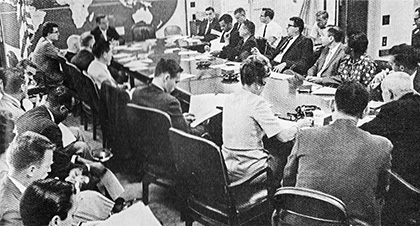
Senior Staff Meeting
In these old photos, most of the women are in chairs shoved back up against the walls, sitting behind the men and waiting to be called upon for some piece of information that the men had forgotten. There, of course, against the walls and watching the boys at play, they would amuse themselves by observing all of the Super Egos trying to impress Shriver.
Looking at these old black-and-white photos one is struck by two things: 1) everyone is smoking; 2) few women at the conference table. It could have been a scene from “Mad Men.” Actually, come to think of it, in many ways that early Peace Corps was Mad Men!
Jane Campbell Beaven, who worked in the Division of Volunteer Support, and later as staff in Ethiopia, before going over to UNICEF, tells of observing the Senior Staff scribbling notes on yellow legal pads and frantically slipping them back and forth across the wide, waxed conference table. “They reminded me,” she later recalled, “of little third grade boys passing notes behind the teacher’s back.”
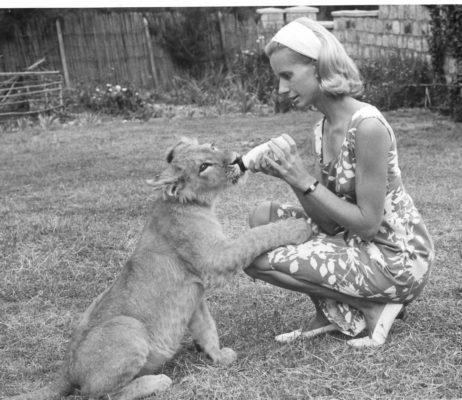
Jane Campbell Beaven
Jane, who had already traveled through East Africa, and written, with John Middleton, the book Zanzibar, Its Society and Its Politics, would by 1964 go overseas to Ethiopia as an APCD. There, in Addis Ababa, she would also raise lion cubs and was the only person in the Empire, besides His Majesty Haile Selassie, to have her own lions playing on her front lawn.
The Women Up Against the Wall, however, were powerful in their own right. Some of the noted female staffers were: Maryann Orlando, Sally Bowles, Nancy Gore, Nan McEvoy, Diana MacArthur, Patricia Sullivan, Alice Gilbert, Betty Harris, Ruth Olson, Dorothy Mead Jacobsen.
Several women, particularly Betty Harris and Sally Bowles, heavily influenced agency decisions, especially decisions about the role of women in the Peace Corps. Sally Bowles, for example, would play a silent, and very important role, in advising Sarge. At the time, she was only around twenty-three-years old. Betty Harris would play a large role on the whole role of what would the agency do with the PCVs who became pregnant in the Peace Corps.
Here are quick profiles of some of the other women staffers.
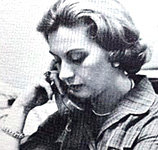
Many Ann Orlando
Mary Ann Orlando is the one person Sarge brought with him when he left Chicago for the Peace Corps. She was born and raised in Chicago, and went to work at the vast Merchandise Mart in 1946. When Shriver arrived in 1948 to take charge of the Mart, Mary Ann became his secretary and at the start of the Peace Corps had already worked for him for 13 years. Her title at the Peace Corps was Confidential Assistant to the Director. Mary Ann would go with Shriver to OEO, and then later into his private practice. No one–and I mean no one–could get to Shriver in his office unless they could talk their way around Mary Ann Orlando.
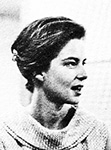
Nancy Gore
Al Gore has has said on a few occasions that his older sister, Nancy Gore, was a Peace Corps Volunteer. While Nancy Gore did have a Peace Corps history, she was never a Volunteer. Nancy was the daughter of Tennessee Senator Albert Gore. She had graduated from Vanderbilt with a degree in history, and had also studied in Monterrey, Mexico, Caen, France, and the Sorbonne. She was a guide at the Brussels World Fair in ’58, and had travelled in Europe and Asia. Also, as a senator’s daughter, she had worked for the Democratic National Committee, and in the early days of the Peace Corps she had the title of assistant to the Associate Director for Planning and Evaluation, Bill Haddad, who would go onto run for Congress in New York State. [Nancy would later become Bill Moyers’ assistant.] At the time Nancy was “dating” [as we said at the time] David Halberstam, who was then writing for The New York Times. In the building at 806 Connecticut Avenue she was known as the “resident Scarlett O’Hara.” Beautiful Nancy was one of the first twelve people working at HQ in March 1961. She would die in 1984 at the age of 46 of lung cancer.
Jean Hundley went to work for the Peace Corps before there was a Peace Corps—two weeks before the executive order of March 1. She brought to her job the benefit of seven years’ experience with ICA and other predecessor organizations to AID. I believe that she was ‘recruited’ for the agency by Warren Wiggins and Bill Josephson, both of who were at the International Cooperation Administration. While the new “Peace Corps” was getting a lot of attention in Washington, going to work in the Maiatico Building it was still a risky step for a career government employee. Jean worked in the office with recruiting chief Dick Graham. Born and raised in Washington, she was a mother of two children.
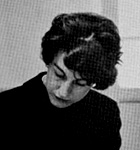
Sally Bolles
Working with Nancy, sharing an office, was another ‘famous daughter,” Sally Bowles. Sally was the daughter of Ambassador Chester Bowles. She was an honor graduate in history from Smith College where she was editor of the college newspaper and president of the student body. She has traveled and lived in Southeast Asia, India, Mexico, Morocco, France and Spain. She served as legislative assistant to Congressman John Brademas, and as administrative assistant to Solicitor General Archibald Cox.
She arrived for work at the Peace Corps on March 1, 1961, and went to work as a Volunteer Liaison Officer in the Division of Volunteer Field Services. Beyond this title, Sarge often called on Sally to make special trips overseas for him, to advice him on the performance of overseas Rep.
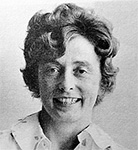
Nan Tucker McEvoy
Bluestocking Nan Tucker McEvoy, Deputy Director of Africa Program, was a reporter who had covered state politics in California, national politics in Washington and international conferences and events during ten years with The San Francisco Chronicle, The New York Herald Tribune and the Washington Post. Her grandfather, Michael de Young, founded the San Francisco Chronicle in 1865. As the only child of Phyllis de Young Tucker, she inherited one-third ownership of the Chronicle Publishing Company and headed the board from 1981 to 1995. Today, she owns a 550 acre ranch in California and is the largest producer of organic estate-grown olive oil in the nation.
Liaison officer Gloria Gaston received her B.A. in sociology from the University of Washington and once studied
acting under Uta Hagen. She has served as radio and television coordinator for the American Society of African Culture in New York City. During and after college, she spent six successive summers in Paris where she worked for the Council on Student Travel and for UNESCO. She came to the Peace Corps on May 2, 1962, where she handled matters directly involving Volunteers. Her duties have taken her on temporary duty to Ghana and other nations of West Africa.
•
There was also the famous West Africa desk officer who Peace Corps Evaluator Fletcher Knebel captured  wonderfully in his 1966 novel on the Peace Corps, The Zinzin Road.
wonderfully in his 1966 novel on the Peace Corps, The Zinzin Road.
Knebel called his character Maureen Sutherland,
. . . a slim, willowy young woman, stylishly dressed. . .. She wore elongated dark glasses, and a sheaf of black hair fell loosely over one eye. Her skin, as creamy as enameled china, hinted of regular facials and a variety of expensive oils and ointments.
Sutherland was based exactly on a legendary Africa Region desk officer. She was famous for flying into West Africa for a brief, whirlwind fact-finding trip, which she breezily referred to as a “look/see.”
Knebel describes his PC/W official on a visit to Africa —
Miss Sutherland lilted on for half an hour, festively dropping names from Lagos to Washington . . . she gave a glittering panorama of the world of great affairs, its intrigues, its grand policies and even its illicit loves. . .. She concluded on a pitch of finishing-school breathlessness and looked about brightly as thought waiting for applause.
All true. But she was a good desk office. Late in the day she would — without telling anyone — go down to the Selection Office and pull the files and look through the applicants and pick the PCVs she wanted for West Africa. Those were the days when as an Overseas Rep you needed a Desk Officer who could work the Selection system if you wanted the best PCVs.
Among the Man Men of the first Peace Corps HQ, she held her own, and beat them at their game of passing notes across the wide waxed conference table, and she did it right under Shriver’s nose.
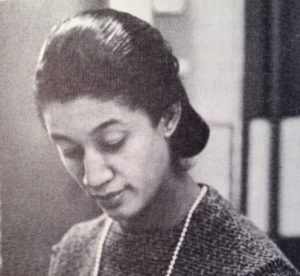
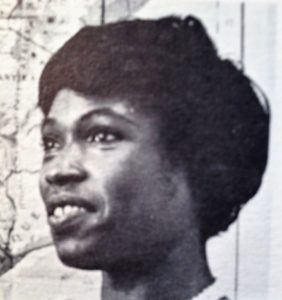
In the Senior Staff Meeting photo, two women can be seen sitting at the table, one on each side. What are their names and what were their jobs? What year was this photo taken and by whom?
And “… what would the agency do with the PCVs who became pregnant in the Peace Corps”?
Thank you,
Beverly Hammons
RPCV Ecuador 1970-73
1961
Betty Harris on this side of the table
I’m not sure who was on the other side. I wasn’t there. I was in Ethiopia.
It might have been Gloria Gaston, a liaison officer at the agency.
I have written extensively about the issue of getting pregnant. I could post them, or you could look on the site. Look for “Mad Men” it was a big issue early in the Peace Corps and it was the “Kennedy women” who told Sarge what to do.
Beverly, go back and read the Betty Harris saga on this blog item and what follows and you’ll get the story of the pregnant issue for the Peace Corps.
http://peacecorpsworldwide.org/mad-woman/
Beverly,
The series is excellent, Here are the links to all the rest of the articles, which begins with John’s link, above.
http://peacecorpsworldwide.org/?s=Mad+Woman+Part+two
http://peacecorpsworldwide.org/?s=Mad+woman+Part+Three
http://peacecorpsworldwide.org/?s=Mad+Woman+Part+Four
http://peacecorpsworldwide.org/?s=Mad+Woman+Part+Five
http://peacecorpsworldwide.org/?s=Mad+Woman+Part+Six
Gloria Gaston what a name from my days in PC/W . A very impressive woman who worked in Africa Region with C. Payne. During the early Joe Blatchford years the Senior Staff was invited to the Nixon White House for a Sunday morning Prayer “breakfast”. Lots of discussion as to whether we should go . I can still hear Gloria saying “If you go to a man’s house how could you criticize him? I. Can’t go.”
Is there any more info and or pictures of Jean Campbell Beaven. Later known as Joan or vice versa.. She recently passed at age 89. No obituary was written for her.
Who was the West Africa desk officer referred to in this article and Fletcher Knebel’s fun book, “The Zinzin Road”? I worked with Cynthia Courtney, who was the Nigeria desk officer in the early ‘60s. Is that who Knebel is referring to?
Hello. Cynthia Courtney was my history teacher in high school and had a profound effect on me that exists to this day. I would love to chat with you and learn more about what she did in the Peace Corps. She used to show us slides in class and tell us about it. Here is the link to my learning center, which I named for her: https://www.hkatherinefisher.com/. Please get in touch; I would love to talk to you. Thank you very much. Katherine
No, it wasn’t Cynthia. I can’t remember her name, but I’ll check around and see if I can find it.
There was another senior woman in the Africa Region at the time — Francesca Gobbi — but I think she was assigned to the French speaking countries. Cynthia definitely was the Nigerian desk officer in ‘62 and ‘63 when I was there.
David, that’s who it was Francesc Gobbi!
Is there any more info and or pictures of Jean Campbell Beaven. Later known as Joan or vice versa.. She recently passed at age 89. No obituary was written for her.